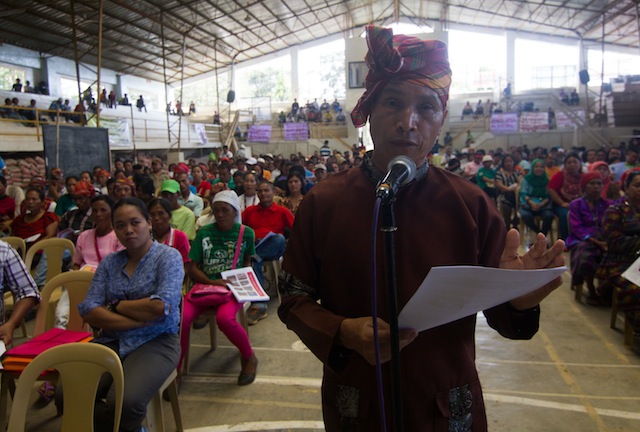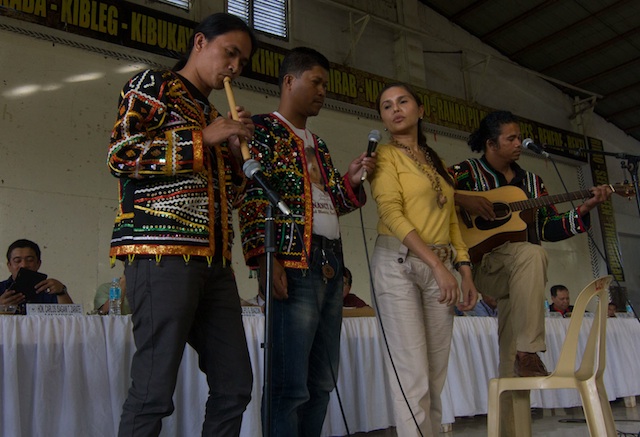UPI, Maguindanao (MindaNews/26 October) — The chair of the House of Representatives’ Ad Hoc Committee on the Bangsamoro Basic Law (AHCBBL) has assured residents of this predominantly Lumad town that what the Indigenous Peoples Rights Act (IPRA) has given them will not be diminished but will instead be enhanced in the future Bangsamoro.
“It will be IPRA plus plus plus,” Cagayan de Oro Rep. Rufus Rodriguez, chair of the 75-member AHCBBL told a crowd of about 400 at the Upi School Gym during the public hearing on October 22, the first out of town hearing on what is now House Bill 4994.
“Do not worry. IPRA will be applicable (in the Bangsamoro). It is applicable now, it is applicable in the future, Rodriguez said, to the delight of IP groups pushing for the specific mention of RA 8371 or IPRA in the BBL.
HB 4994 does not specifically mention IPRA but both government (GPH) and the Moro Islamic Liberation Front (MILF) claim it provides for all the rights guaranteed under IPRA, a national law passed on October 29, 1997 but not implemented in the IP areas under the Autonomous Region in Muslim Mindanao (ARMM), the core territory of the proposed Bangsamoro government.
The proposed BBL “recognizes, promotes and protects the rights” of the IPS to: their native titles and/or fusaka inged, indigenous customs and traditions, justice systems and indigenous political structures; an equitable share in revenues from the utilization of resources in their ancestral lands; free and prior informed consent; political participation in the Bangsamoro Government including reserved seats for the Indigenous Peoples in the Bangsamoro Parliament; basic services; freedom of choice as to their identity.
Representation
It also provides that non-Moro IPs within the Bangsamoro territory are guaranteed representation in the executive, legislative and judicial branches of the new autonomous political entity that will adopt a parliamentary system of government.
In the executive branch, the IPs will have a seat in the Cabinet representing the Office or Ministry for Indigenous Peoples and a seat in the Bangsamoro Council of Elders that would advise the Chief Minister on matters of governance; in the legislative, the IPs are guaranteed two reserved seats in the 60-member Parliament, and possible additional seats as district representatives; and in the judiciary, the BBL provides the application of tribal justice for the IPs as well as an Office for Tribal Justice System.
During the transition period that will start upon the ratification of the BBL, the IPs, according to the proposed law, are also guaranteed representation in the 50-member Bangsamoro Transition Authority (BTA), and the membership in the Council of Elders.
The President will appoint members to the 50-member BTA from nominations sent to his office.
IPs will also be represented in the interim Cabinet, which will be composed of 10 offices including one for “Indigenous Peoples Affairs.”
The proposed BBL was initially drafted by a 15-member Bangsamoro Transition Commission (BTC) composed of eight members nominated by the MILF and seven members nominated by the GPH, including two IP commissioners, both of them Teduray – GPH nominee Froilyn Mendoza, and MILF nominee Timuay Melanio Ulama.
Mendoza signed the draft BBL submitted to Malacanang on April 22, “with reservations” as some of the issues she fought for, among them the recognition of IPRA within the BBL and “ancestral domains” instead of just “ancestral domain,” were not included in the draft.
“Proposed alternative provisions”
Timuay Santos Magay Unsad of the Timuay Justice and Governance offered at least 16 “proposed alternative provisions” to the BBL which he said was “a product of a series of consultations and discussion conducted by a study group composed of IP leaders and civil society representatives.
 Timuay Santos Unsad of the Timuay Justice and Governance. MindaNews photo by Toto Lozano
Timuay Santos Unsad of the Timuay Justice and Governance. MindaNews photo by Toto Lozano
Among these are the insertion of the definition of IPs under Article Section on Bangsamoro Identity, to mean “all indigenous cultural communities/indigenous peoples under Indigenous Peoples Rights Act;” an addition in Article on the Bangsamoro territory that would specifically state that “ancestral domains of Indigenous Peoples shall be recognized and respected in accordance with the provisions of the Indigenous Peoples Rights Act, UNDRIP and other international instruments” and that the law should provide that “Nothing in this basic law shall diminish or undermine any and all rights and benefits already possessed and enjoyed by Indigenous Peoples under the Constitution, statutes, customary laws, and international law.”
BTC Commissioner Mendoza, co- founder of the Teduray Lambangian Women’s Organization, told the Committee that their identity as IP is “a birthright” and “hindi ito simpleng usapin lamang ng ‘freedom of choice’ that has been agreed and defined by both MILF and government.”
Mendoza also stressed that “ancestral domain” in the BBL should be changed to “ancestral domains” to “recognize that there are ancestral domains in the Bangsamoro belonging to the IPs consistent with the context of ancestral domain in the IPRA.”
Tribal Justice
Section 24 under Article 10 on the Bangsamoro Justice System, provides for the creation of an Office for Tribal Justice System “responsible in overseeing the study, preservation and development of the tribal justice system within the Bangsamoro.”
 Commissioner Froilyn Mendoza, one of two IP representatives in the 15-member Bangsamoro Transition Commission. MindaNews photo by Toto Lozano
Commissioner Froilyn Mendoza, one of two IP representatives in the 15-member Bangsamoro Transition Commission. MindaNews photo by Toto Lozano
Mendoza said that while the IPs will define the system, the Bangsamoro Parliament still has to legislate it and based on their experience under the ARMM since its establishment in 1990, “not much has been enacted in terms of regional legislation that protects and promotes (IP) rights and welfare.”
She said they are worried the same would happen again under the Bangsamoro.
Unsad’s study group prefers that the same Section 24 be revised to read that it would be “responsible for the delivery of financial, technical, legal and other institutional support to the tribal justice system within the Bangsamoro” instead of merely stating it would be “overseeing the study, preservation and development of the tribal justice system within the Bangsamoro.”
B’laan Datu Antonio Kinoc of Davao del Sur, an alternate member of the MILF peace panel who asked to speak after Mendoza, explained he was not supposed to say anything because the BBL is a product of negotiations between government and the MILF “but I cannot allow what has just happened,” he said, adding that it was a “waste of precious time” as Mendoza “should not make the forum as a venue to ventilate what has been taken over by the BTC.”
Kinoc moved that “everything she said be stricken off the record” but Rodriguez replied he cannot have Mendoza’s statements deleted because “this is a public hearing, everyone has the right to speak” and that the Committee invited Mendoza to speak.
Breaking the tension
North Cotabato Rep. Nancy Catamco, chair of the House Committee on National Cultural Communities, broke the tension by singing three songs on Unity and Peace with her three-man band from fellow members of the Obo-Manobo tribe in North Cotabato.
 North Cotabato Rep. Nancy Catamco, chair of the National Cultural Communities, sings songs on Unity and Peace with her fellow Obo-Manobos during the public hearing in Upi, Maguindanao on October 22. MindaNews photo by Toto Lozano
North Cotabato Rep. Nancy Catamco, chair of the National Cultural Communities, sings songs on Unity and Peace with her fellow Obo-Manobos during the public hearing in Upi, Maguindanao on October 22. MindaNews photo by Toto Lozano
Rodriguez said it was the first time in a public hearing that a Committee member sang. (Catamco and her band would sing again in Cotabato City on October 23 and Koronadal City the next day).
Rodriguez and 10 other members of the 75-member AHCBBL came to the hearing attended mostly by IPs.
The participants were clearly divided between those who are supporting the BBL without reservations and those supporting it with reservations, in the messages delivered not only through their representatives but also through their tarpaulins and sack streamers, and by their applause upon hearing a key word.
According to an IP Dev 2013 survey among 80 barangays in 12 towns “with sizeable IP population” in the mainland of the ARMM the total Lumad population there is 117,189, with the Tedurays numbering 110,559, followed by the Lambangian with ,139, the Dulangan Manobo with ,904, Higaonon with 161 and 17 other ethnic affiliations with less than a hundred each.
The ARMM has a population of .7 million as of 2013, according to its website.
BTC Commissioner Ulama said IP leaders held consultations after IPRA was passed in 1997. He recalled that three months the National Commission on the Indigenous Peoples (NCIP) was established, they submitted a resolution to its central office, copy furnished Malacanang, to implement IPRA in the ARMM but they got no response.
Fatima Kanakan, Executive Director of the Office of Southern Cultural Communities (OSCC) in the ARMM, said “IPRA in truth and in fact was adopted in the ARMM through Resolution 269 of the RLA (Regional Legislative Assembly) way back in 2003.” She said the problem is that “the NCIP failed to devolve its functions in the ARMM so we cannot move with the delineation process and all aspects of identification, delineation” and blamed former NCIP commissioners like Unsad.
Kanakan’s statement at the public hearing drew an angry reaction from Fr. Eliseo Mercado, former Notre Dame University President and a consultant at the Institute for Autonomy and Governance.
Mercado posted on his Facebook wall that the RLA resolution was just a resolution and did “not enshrine the four bundles of rights that make and shape the soul and flesh of IPRA.”
Kanakan responded to Mercado’s post by saying the ARMM was not remiss in having IPRA implemented in the ARMM and maintained there was no parallel action on the part of the NCIP to implement IPRA.
IPRA’s status in ARMM
ARMM Executive Secretary Laisa Alamia told MindaNews the RLA resolution on IPRA a decade ago had “never been implemented.”
“There’s no NCIP in the ARMM. The OSCC which is the agency in charge of IP affairs, is not authorized under the law to implement IPRA, particularly on ancestral domain,” she said.
Alamia said the framers of IPRA did not consider the structure and system in ARMM when it was passed in 1997, seven years after the ARMM was established.
“In the ARMM, all land titles (cadastral survey, CLOA, etc) are finally approved and signed by the Regional Governor (RG). IPRA is silent on this. It’s either IPRA is amended to take into consideration the ARMM/Bangsamoro structure or an IPRA law is passed in ARMM/Bangsamoro,” she said.
The administration of Governor Mujiv Hataman gave hope to the IPs in September 2013 when he and NCIP chair Leonor Oralde-Quintayo agreed to sign a Memorandum of Agreement (MOA) for the implementation of the provisions of IPRA especially those that are related to the ancestral domain delineation, supposedly as part of a confidence building measure for affected IPs in the Bangsamoro peace negotiations.
But the MOA signing did not push through and after the Annex on Power-Sharing was signed in Kuala Lumpur in early December 2013, the IPs said in a Declaration that they were “surprised that all provisions for the IP agenda in the peace process were devolved entirely by the GPH to the ‘exclusive power’ of the Bangsamoro without consideration to our positions submitted to the GPH and MILF since 2005, and to the present through the Bangsamoro Transition Commission.”
Alamia explained that the MOA was not signed because “IP groups submitted a position paper/petition to stop the MOA signing.”
“What RG did was to let their (IP) Council of Leaders agree muna among themselves and thresh out their issues before the MOA can push through. Merong (IPs) for the MOA pero merong ding against the MOA. We’re caught in the middle. In the meantime, status quo. We’ve also increased the programs and projects in the Upi towns (main, north and south), and resolved their intra-ethnic ridos or responded to rido-induced displacement. Meron ding Maguindanaon vs Teduray rido. And it’s usually land conflict,” Alamia said.
On January 10 this year, the NCIP en banc passed Resolution 06-001-2014 “to address the condition of the Teduray, Lambangian and Dulangan Manobo for the recognition and protection of their rights to the ancestral domains.”
The resolution said Mindanao is “home to the Indigenous Peoples belonging to the Teduray, Lambangian and Manobo Dulangan ICCs/IPs with identified ancestral domains” and that as of that date, “despite the passage of the IPRA, the fight for recognition of the IPs’ ancestral domain has remained a challenge for the said communities, given the political atmosphere in the areas where they are located.”
The resolution directed the regional office of the NCIP to “act on the applications and facilitate the processing of the CADT applications of the above-identified communities, including exploring areas of collaboration with and/or engaging in a partnership with CSO,s NGOs, LGUs and other stakeholders to realize the goal of issuing CADTs to the applicant communities.”
The resolution was immediately shared by Unsad through Facebook on January 13. When anthropologist Oona Paredes asked for which communities, Timuay Alim Bandara said the resolution was “for the unified CADT application of the Teduray, Lambangian and Dulangan Manobo in portions of Maguindanao, ARMM filed at NCIP in September 2005, with an estimated land area of 201,850 hectares.”
Since there is no NCIP office in the ARMM, the task was given to the NCIP in neighboring Region 12 which is implementing the resolution.
Alamia, a lawyer and former chair of the ARMM’s Regional Human Rights Commission, said there is a conflict of law in this situation. “RA 9054 (the law
governing ARMM), together with ARMM Administrative Code vs IPRA. Which prevails? Under RA 9054, it is the regional government that has jurisdiction over ARMM, including IP concerns. But the provisions do not include the provisions that are found under IPRA with respect to CADT. How do we reconcile this in the meantime? NCIP can implement IPRA in the ARMM but to do that it has to go into MOA with ARMM. It cannot just get into ARMM and do its mandate without respecting the autonomy given to ARMM as enshrined in the Constitution and under RA 9054.
Meanwhile, the IPs are waiting. (Carolyn O. Arguillas/MindaNews)
